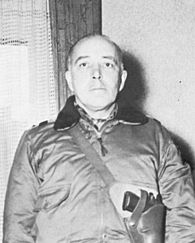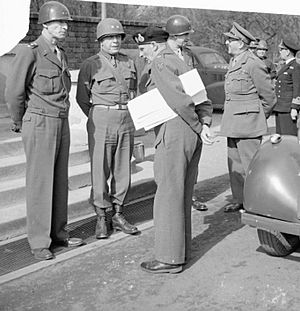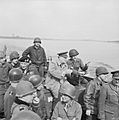John B. Anderson (United States Army officer) facts for kids
Quick facts for kids
John Benjamin Anderson
|
|
|---|---|
 |
|
| Born | March 10, 1891 Parkersburg, Iowa, United States |
| Died | September 1, 1976 (aged 85) Washington, D.C., United States |
| Allegiance | |
| Service/ |
|
| Years of service | 1914–1946 |
| Rank | |
| Service number | 0-3686 |
| Unit | |
| Commands held | 1st Battalion, 6th Field Artillery Regiment 2nd Battalion, 24th Field Artillery Regiment 102nd Infantry Division XVI Corps |
| Battles/wars | Pancho Villa Expedition World War I World War II |
| Awards | Army Distinguished Service Medal Legion of Merit Bronze Star |
John Benjamin Anderson (born March 10, 1891 – died September 1, 1976) was an important American Army officer. He reached the rank of Major General. During World War II, he led a large group of soldiers called the XVI Corps.
Contents
Biography
Early Life and Military Start
John Benjamin Anderson was born on March 10, 1891, in Parkersburg, Iowa. His parents, Carl Christian and Louisa Anderson, were immigrants from Denmark. John was the youngest of their seven children.
After finishing high school in 1910, John went to the United States Military Academy (USMA) in West Point, New York. He graduated on June 12, 1914. This was just before World War I began in Europe. On the day he graduated, John became a second lieutenant in the Field Artillery Branch of the United States Army. Many of his classmates also became general officers during World War II.
John was then sent to the 6th Field Artillery Regiment. His unit moved to El Paso, Texas. There, he served on the Mexican border in 1916. This was during the Pancho Villa Expedition. The United States officially joined World War I on April 6, 1917. John was still serving on the border at that time.
During World War I, John and his regiment went to the Western Front in France. They were part of the new 1st Infantry Division. In October and November 1917, he worked as a regimental adjutant in the Somme area. This place had seen a lot of fierce fighting the year before.
In the spring of 1918, John served with the British Expeditionary Force (BEF) in Ypres, Belgium. Later, he became the adjutant for the 1st Artillery Brigade. He then returned to his 6th Artillery Regiment. There, he commanded a battery and later a battalion. He led his battalion during the Battle of Cantigny. John continued in this role until the war ended. The war finished when the Armistice with Germany was signed on November 11, 1918.
Between the Big Wars
After the war, John Benjamin Anderson returned to the United States in 1919. He was sent to Fort Sill, Oklahoma. There, he became an instructor at the U.S. Army Field Artillery School. He also took an advanced course at this school from 1922 to 1923.
In June 1925, John attended the U.S. Army Command and General Staff School in Fort Leavenworth, Kansas. After that, he commanded a battalion of the 24th Field Artillery Regiment. This was at Fort Stotsenburg, Philippines, until July 1927.
From September 1927 to June 1928, John studied at the U.S. Army War College in Washington, D.C.. He then joined the personnel division of the War Department General Staff. In 1929, he went to Geneva, Switzerland. He was one of the U.S. Army representatives at a conference. This meeting was about the rules for treating prisoners of war.
John was later transferred to the 13th Field Artillery Regiment at Fort Bragg, North Carolina. He served there until September 1934. After that, he became an instructor at the U.S. Army Command and General Staff School. This was back at Fort Leavenworth, Kansas. During this time, he was promoted to the rank of lieutenant colonel.
In July 1938, John Benjamin Anderson moved to the Office of the Chief of Artillery in Washington, D.C. He became the Chief of the Personnel Section. In October 1941, he was promoted again. He became a one-star general officer, a brigadier general. This was just before the United States entered World War II.
Leading in World War II
A month after becoming a brigadier general, John was made the Chief Artillery officer of the 2nd Infantry Division. This division was stationed at Fort Sam Houston, Texas. It was led by Major General John C. H. Lee. On August 4, 1942, John Benjamin Anderson was promoted to a two-star general. He became a major general.
On September 15, the 102nd Infantry Division was formed at Camp Maxey, Texas. Major General John Benjamin Anderson became its first Commanding General (CG). He helped train his division until December 1943. Then, he passed command of the 102nd to Major General Frank Keating.
In December 1943, the XVI Corps was created at Fort Riley, Kansas. John Benjamin Anderson took command in early January 1944. The XVI Corps took part in winter training exercises in Watersmeet Township, Michigan. Later, it was sent to the European Theater of Operations (ETO). This was the main area of fighting in Europe.

John Benjamin Anderson led the XVI Corps on the Western Front. His corps was part of the U.S. Ninth Army. They fought in the Rhineland Campaign and the Central Europe Campaign. Under John Benjamin Anderson's command, the XVI Corps helped free the Dutch city of Roermond. They also fought in the Ruhr Pocket.
For his strong leadership, John Benjamin Anderson received several awards. These included the Army Distinguished Service Medal, the Legion of Merit, and the Bronze Star. He also received awards from other countries.
After the War
On June 6, 1945, the city of Roermond, Netherlands, held a big celebration. They honored General John Benjamin Anderson and the XVI Corps for freeing their city. As part of the celebration, a major road was renamed "Andersonweg" (Anderson Street). A special plaque was also placed on a building to remember the event.
Major General Thomas D. Finley took over command of XVI Corps in October 1945. John Benjamin Anderson then returned to the United States. He retired from the army the next year, on June 30, 1946. He had served for 33 years. He retired because of a disability.
John Benjamin Anderson passed away on September 1, 1976, at 85 years old. He died in Washington, D.C.. He is buried with his wife, Sue Palmer Anderson (1901–1991), at Arlington National Cemetery, Virginia.
Awards and Decorations
Here are the awards John Benjamin Anderson received:
| 1st Row | Army Distinguished Service Medal | Legion of Merit | Bronze Star Medal | |||||||||||||
|---|---|---|---|---|---|---|---|---|---|---|---|---|---|---|---|---|
| 2nd Row | Mexican Service Medal | World War I Victory Medal with two battle clasps | Army of Occupation of Germany Medal | American Defense Service Medal | ||||||||||||
| 3rd Row | American Campaign Medal | European–African–Middle Eastern Campaign Medal with four service stars | World War II Victory Medal | Army of Occupation Medal | ||||||||||||
| 4th Row | Officer of the Legion of Honor (France) | French Croix de guerre 1939–1945 with Palm | Grand officer of the Dutch Order of Orange-Nassau | Belgian Croix de guerre 1940–1945 with Palm | ||||||||||||
Images for kids
-
The British Prime Minister, Winston Churchill (center), crosses the River Rhine. He is in an American boat with Field Marshal Sir Bernard Montgomery (left of Churchill). Also present are U.S. Lieutenant General William H. Simpson, Field Marshal Sir Alan Brooke, U.S. Major General Leland Hobbs, Major General John B. Anderson, and Major General Ira T. Wyche. This picture was taken on March 25, 1945.
-
The grave of Major General John B. Anderson at Arlington National Cemetery.



